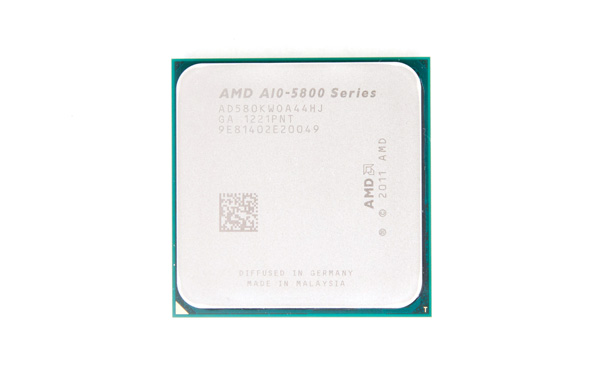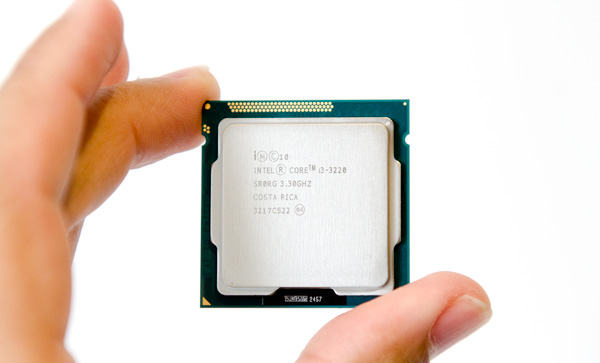AMD A10-5800K & A8-5600K Review: Trinity on the Desktop, Part 2
by Anand Lal Shimpi on October 2, 2012 1:45 AM ESTAlthough AMD's second-generation mainstream APU platform, codename Trinity, launched months ago in notebooks the official desktop launch is today. Rumor has it that AMD purposefully delayed the desktop Trinity launch to clear out unsold Llano inventories in the channel. Although selling APUs in notebooks is pretty easy, convincing desktop users to forgo the discrete GPU option (and ignore Intel) has been a tough battle for AMD. I keep going back to two slides that show us where AMD wants to go and the cores it'll take to get there:

The ultimate goal is this beautiful cohesive operation between CPU and GPU on a single die. That future will require a lot of software support, not only at the application level but also at the OS level. And I'm not talking about Windows 8. We're still far away from this APU dominated future, but AMD is marching in that direction. The second slide shows the x86 cores that we'll see from AMD along the way. AMD is still playing catch-up in the x86 CPU space and it's got a lot of lost time to make up for. There's no hiding the fact this is going to be a multi-year effort to simply get close to Intel's single-threaded x86 performance. Through pricing, leveraging its GPU technology and throwing more transistors at the problem AMD can still deliver competitive solutions, but it's not going to be a walk in the park.
Last week we took a look at the GPU side of the desktop Trinity APUs. We looked at the top end 384-core Radeon HD 7660D configuration as well as the slightly slower 256-core Radeon HD 7560D GPU, both of which easily outperformed Intel's HD 4000 and HD 2500. As far as processor graphics go, Trinity on the desktop maintains a healthy lead over Intel. There's still a place for discrete GPUs but that's pretty much at the $100 and above price points.
Today we're able to talk about pricing and x86 CPU performance among other things. The good news on that front is the most expensive Trinity APU is fully unlocked and is priced at $122:
| AMD Socket-FM2 Lineup | ||||||||
| Modules/Cores | CPU Clock Base/Turbo | L2 Cache | GPU | TDP | Price | |||
| A10-5800K | 2 / 4 | 3.8 / 4.2 GHz | 4MB | 384 cores @ 800MHz | 100W | $122 | ||
| A10-5700 | 2 / 4 | 3.4 / 4.0 GHz | 4MB | 384 cores @ 760MHz | 65W | $122 | ||
| A8-5600K | 2 / 4 | 3.6 / 3.9 GHz | 4MB | 256 cores @ 760MHz | 100W | $101 | ||
| A8-5500 | 2 / 4 | 3.2 / 3.7 GHz | 4MB | 256 cores @ 760MHz | 65W | $101 | ||
| A6-5400K | 1 / 2 | 3.6 / 3.8 GHz | 1MB | 192 cores @ 760MHz | 65W | $67 | ||
| A4-5300 | 1 / 2 | 3.4 / 3.6 GHz | 1MB | 128 cores @ 724MHz | 65W | $53 | ||
| Athlon X4 750K | 2 / 4 | 3.4 / 4.0 GHz | 4MB | N/A | 100W | $81 | ||
| Athlon X4 740 | 2 / 4 | 3.2 / 3.7 GHz | 4MB | N/A | 65W | $71 | ||
Compare this to Llano's launch where the top end SKU launched at $135 and you'll see that AMD is somewhat getting with the times. I would still like to see something closer to $100 for the A10-5800K, but I find that I'm usually asking for a better deal than what most CPU makers are willing to give me.
AMD's competitive target is Intel's newly released Ivy Bridge Core i3 processors. There are only five Core i3s on the market today, four of which use Intel's HD 2500 graphics. The cheapest of the lineup is the Core i3 3220 with two cores running at 3.3GHz for $125. Intel disables turbo and other features (there's effectively no overclocking on these parts), which AMD is attempting to exploit by pitting its Trinity K-series SKUs (fully unlocked) against them. AMD's TDPs are noticeably higher (100W for the higher end K-series parts compared to 55W for the Core i3s). Intel will easily maintain the power advantage as a result under both CPU and GPU load, although AMD's GPU does deliver more performance per watt. Power consumption is a major concern of AMD's at this point. Without a new process node to move to for a while, AMD is hoping to rely on some design tricks to improve things in the future.
At the low end of the stack there are also two Athlon X4s without any active GPU if you just want a traditional Trinity CPU.
The Test
This will be our last CPU/APU review on the current test platform/software configuration. The next major CPU review will see a move to a brand new testbed running Windows 8. As always you can get access to far more numbers than what we report here if you use our performance comparison engine: Bench. Of course if you want to see the GPU and GPU Compute performance of AMD's Trinity APU check out part one of our coverage.
| Motherboard: |
ASUS P8Z68-V Pro (Intel Z68) ASUS Crosshair V Formula (AMD 990FX) Gigabyte GA-F2A85X-UP4 (AMD A85X) Intel DZ77GA-70K (Intel Z77) |
| Hard Disk: |
Intel X25-M SSD (80GB) Crucial RealSSD C300 OCZ Agility 3 (240GB) |
| Memory: | 2 x 4GB G.Skill Ripjaws X DDR3-1600 9-9-9-20 |
| Video Card: |
ATI Radeon HD 5870 (Windows 7) AMD Processor Graphics Intel Processor Graphics |
| Video Drivers: | AMD Catalyst 12.8 |
| Desktop Resolution: | 1920 x 1200 |
| OS: | Windows 7 x64 |













178 Comments
View All Comments
Jamahl - Tuesday, October 2, 2012 - link
According to kitguru, the 5800K + 7970 GHz edition beats the i3 2105 in every single game at 1080p.mikato - Wednesday, October 3, 2012 - link
lolwut? is that using i3's integrated graphics? Please extend your comment a little more to the point it makes sense.CeriseCogburn - Tuesday, October 9, 2012 - link
AMSheep fanboys tell themselves and everyone else lies, then they go buy the crap and the live the life of a slow and still poor dullard.Next chance they get they rinse and repeat.
kshong - Thursday, October 11, 2012 - link
Your comments add nothing to the conversation and take up space. I wish people could ban trolls like you.bill4 - Tuesday, October 2, 2012 - link
Just looked on newegg and the G850 is $70. The 5800 is supposed to MSRP for $122. I realize Obama is destroying our schools but where is 70 half of 122? Also, that leaves $50, what dedicated GPU worth a crap costs 50 dollars? Even a $100+ 7750 would not be much improvement I'm assuming.Somehow I knew before I checked the prices your comment would be an exaggeration, as I've seen the same type of wrong pricing on other comments like this already. Fanboys, get your facts straight.
Plus, I dont know the exact motherboard situation, but typically AMD motherboards are cheaper as well.
Oh and you pick out one single benchmark, what's the point of that? Looking at all the benches, what do you know, 5800 is faster than G850 easily the vast majority of times. Many times it's not even close, or 5800 can close to double G850 speed (3DSmax39, page 4 lol).
Usually the way it works in computers is, better performing parts cost more.
Usually the Trinity parts compare well with the similar priced Intel part, which is the i3 3220. Case closed.
I dont even necessarily disagree with you, that it might do better to spend a few more bucks on a g850+discrete card combo if you're a gamer (and, I'd need to see actual benchmarks with that combo to be sure) just pointing out a few things. Then again, if you're a gamer you really shouldn't spend less than 700 on a rig anyway, anything less you're buying outside the sweet spot and you just bought a piece of crap. Way PC gaming works, very well defined "sweet spot", buying above or below that spot is usually stupid for gaming.
ac2 - Tuesday, October 2, 2012 - link
Well I guess the reading comprehension is no better...I said "the G850 costs a little more than HALF the A10 suggested price"
69.90 is a little more than half of 122, i.e. 61
Unless we start quibbling how much a 'little more' is...
Lets look at the 3dsmax scores on pg 4 you talk about:
A10 - 11.5
A8 - 11.1
Pentium - 8.6 (double of which is 17.2 but anyway)
My elementary maths tells me its a 33% gain, which is generally the A10's gain over a CPU that costs 42% less... And that too only on the embarassingly parallel tasks..
ac2 - Tuesday, October 2, 2012 - link
Oh and Anand has benched G850 + discrete cards, see here:http://www.anandtech.com/show/4524/the-sandy-bridg...
Looks 'good enough' for me...
And I guess I'm just frustrated with AMD for completely dropping the value for money ball here, except for some highly threaded integer tasks...
eanazag - Tuesday, October 2, 2012 - link
Remember that once you add a discrete part for GPU the power benefits disappear.Roland00Address - Tuesday, October 2, 2012 - link
If you are adding a discrete card do not get the a10, get the Athlon X4 750K (remember it is unlocked) for $81 dollars. It is the trinity fm2 processor but it does not have the iGpu (which you don't care about since you are adding dedicated).It runs 600 mhz less on stock, and 400 mhz less on turbo but guess what you have an unlocked multiplier so you can easily set it at the same frequency as the a10.
It does cost 15 dollars more (g850 goes for 66 the Athlon X4 750k goes for $81) but you will get much better multithread performance than the pentium (in exchange for higher load power consumption)
Some games are going 4 cores (such as Battlefield 3) so the Athlon X4 750k will be better for gaming.
rarson - Wednesday, October 3, 2012 - link
Yeah, because single-threaded performance is so forward-thinking. Intel excels at what everyone is trying to move away from, great.